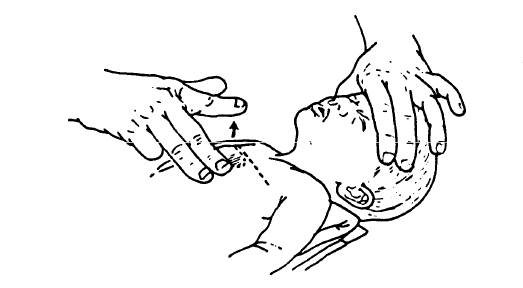Cardiopulmonary Resuscitation
Lesson 6: Perform Cardiopulmonary Resuscitation on a Child or Infant
6-6
6-6. ADMINISTER CARDIOPULMONARY RESUSCITATION
a. Locate Compression Site.
(1) Child. The chest compression site on a child is located on top of the infant's sternum just below an imaginary line connecting the nipples (figure 6-4).
(2) Infant. The chest landmarks on an infant are the same as for the child.
Figure 6-4. Locating the compression site on an infant.
b. Administer Thirty Chest Compressions.
(1) Child.
(a) Use one or two hands to administer chest compressions to a child, depending on the size of the child. The 30:2 compression ratio will be used for one rescuer CPR in the child and infant. For two rescuers the ratio will be 15:2. Press straight down on the heel of your hand over the compression site so that the sternum is depressed 1/3 to 1/2 the total depth of the chest (1 to 1 1/2 inches).
(b) Repeat the compressions at a rate of 100 per minute.
(c) Allow the chest to return to its resting position after each thrust, but do not remove your heel from the compression site. If the compression site is lost, repeat the location procedures before administering more chest thrusts. The thrust and the relaxation parts of the compression should be of equal duration.
(2) Infant.
(a) The infant should be lying on a firm, flat surface before CPR is begun. If needed, you can provide a firm support by slipping your nondominant hand under his back and using your dominant hand to administer compressions.
(b) Chest compressions on an infant should be administered with the tips of the middle and ring fingers. Press straight down so that the sternum is depressed from 1/3 to 1/2 the total depth of the chest (1/2 to 1 inch).
(c) Repeat the compressions at a rate of at least 100 per minute.
(d) Compressions should be smooth, not jerky. Allow the chest to return to its resting position after each thrust, but do not remove your fingertips from the compression site. The thrust and the relaxation parts of the compression should be of equal duration.
c. Administer Two Breaths. After administering the thirtieth compression, administer two slow ventilations. Observe the casualty's chest out of the corner of your eye. Blow just enough air into the casualty's airway to expand his lungs fully.
(1) If possible, seal your mouth over the casualty's mouth and nose and administer mouth-to-mouth-and-nose resuscitation.
(2) If the casualty is an infant, do not remove your fingers from the compression site on his chest. Use only one hand to maintain the infant's airway (fingers on the forehead if the modified head-tilt/chin-lift is used or fingers under one angle of his jaw if the jaw-thrust is used).
d. Perform Four Additional Cardiopulmonary Resuscitation Cycles. Perform four more cycles of 30 compressions and two ventilations.
(1) If the casualty is a child, you should be able to visually relocate the compression site after each set of ventilations without having to repeat the procedures listed in paragraph 4-1d.
(2) If the casualty is an infant, your fingers should still be on the compression site, thus eliminating the need to relocate the site.
e. Check Pulse. After five cycles, check the casualty's pulse again. The check should not take longer than 5 seconds. As you check the pulse, also check for spontaneous breathing.
(1) If the casualty has a pulse and he has resumed breathing on his own, stop administering CPR and begin checking for other injuries. Keep the airway open and check his breathing every few minutes if he does not regain consciousness. Resume administering rescue breathing or CPR if he stops breathing.
(2) If the casualty has a pulse but has not resumed breathing on his own, proceed to administer rescue breathing. Recheck the casualty's pulse every few minutes. If you find the casualty's pulse to be absent, resume administering CPR.
(a) For a child, administer ventilations at the rate of one ventilation every 3 to 5 seconds (12 to 20 ventilations per minute).
(b) For an infant, administer ventilations at the rate of one ventilation every 3 to 5 seconds (12 to 20 ventilations per minute).
(3) If the casualty does not have a pulse, continue to administer thirty chest compressions followed by two breaths. Recheck the pulse again every few minutes. Continue administering CPR until one of the following occurs:
(a) The casualty's heart resumes beating on its own. (If this happens, continue rescue breathing.)
(b) The casualty's heart resumes beating on its own and he also resumes breathing on his own. (If this happens, look for injuries.)
(c) You are relieved by a physician or other medical personnel. (If this happens, provide information on the casualty and follow instructions.)


